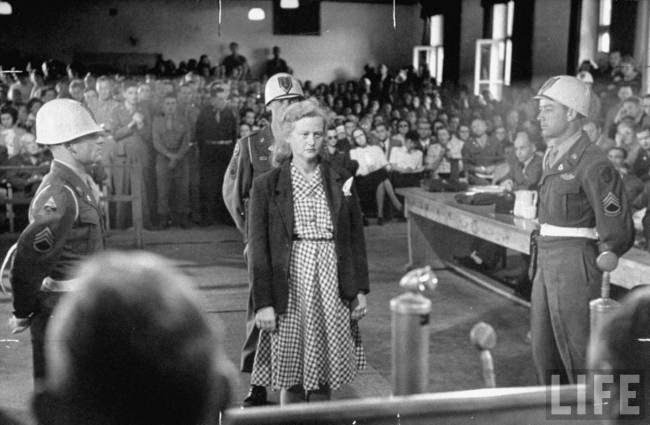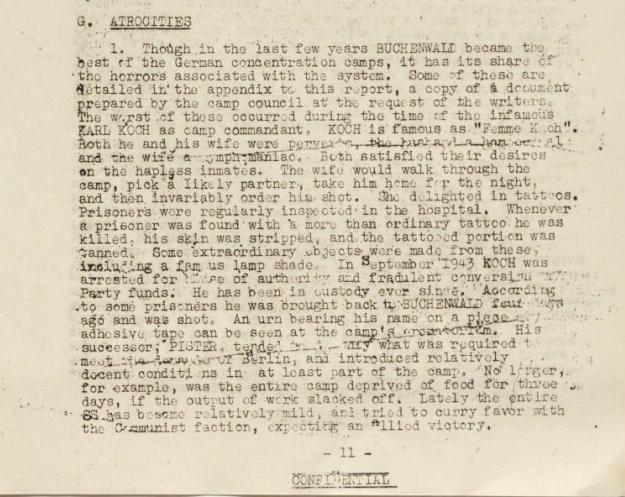Ilse Koch: The Skin Harvester of Buchenwald December 21, 2015
Author: Beach Combing | in : Contemporary , trackbackIlse Koch, ‘the bitch of Buchenwald’, seems to have been an unpleasant human being. She was a sadist, and she was, as a matter of record, – something almost as serious in the 1940s and 1950s when her reputation was made – ‘promiscuous’: she had opportunities to sate both desires as the wife of the head of the Buchenwald Concentration Camp, Karl Otto Koch (1936-1941): and she remained at Buchenwald for two subsequent years after KOK departed. As with most diabolical (and saintly) figures, myths and facts merge and countermerge. She is the origin of the legend (if it is a legend) of the lampshade made from human skin: she was also said to collect tattoos from prisoners (who did not survive the experience: memories of a Roald Dahl short story) or even force prisoners to tattoo each other before being killed. These matters should have been settled judicially after the Second World War: it goes without saying that any of these acts would have been a crime in international or West German law. But her judicial experience was long and contradictory. She was sentenced to death by an American court in August 1947, in part because of the human lampshade incident: but this was reduced to four years on appeal in part because it transpired a lampshade exhibited in court had been made of goat skin. She was subsequently tried, in 1949, by a West German court, which was able to deal only with her acts against German and Austrians in the camp (there were many political prisoners), and the judges sentenced her to life imprisonment. In the German trial allegations were made about tattoos and human lampshades by witnesses: but no physical proof was found. Beach has long been interested in the truth or otherwise of this particularly nasty bit of WW2 trivia: did Ilsa Koch really ‘harvest’ human skin? Or was this apocryphal reflecting the fact that she, as the German court decided, had incited murder: she was, as noted above, not exactly a model human being. Beach was, in any case, fascinated to come across this early evidence, an American report written in mid April 1945, almost immediately after the camp had been liberated. Under the section ‘atrocities’ (11) the following sentences appear:
The worst of these [atrocities] occurred during the time of the infamous KARL KOCH [1937-1941] as camp commandant. KOCH is famous as ‘Femme Koch’ [woman Koch]. Both he and his wife were perverts, the husband a homosexual and the wife a nymphomaniac. Both satisfied their desires on the hapless inmates. The wife [1937-1943 at Buchenwald] would walk through the camp, pick a likely partner, take him home for the night, and then invariably order him shot. She delighted in tattoos. Prisoners were regularly inspected in the hospital. Whenever a prisoner was found with a more than ordinary tattoo he was killed, his skin was stripped, and the tattooed portion was tanned [this looks like canned in the text!]. Some extraordinary objects were made from these including a famous lamp shade.
Of course, not everything reported here need be true. But on the basis of this capably written report (well worth a read), we can be absolutely sure that it was believed by the inmates at Buchenwald, the report writer’s informants. The very fact that the lamp shade was ‘famous’ means that either here was a factual truth: or a Buchenwald urban myth. Note that later versions of this fact/myth do not include the detail that the lamp was tattooed. If we have a fact we have another in the long list of Nazi atrocities or more atrocities allowed by the concentration camp system: if a lampshade is too baroque think about the all too factual gas showers and crematoriums. If it is a myth then the origin may be found in General Clay’s comments (in the appeal that reduced IK’s sentence to four years).
A sordid, disreputable character, [Ilse Koch] had delighted in flaunting her sex, emphasized by tight sweaters and short skirts, before the long-confined male prisoners, and had developed their bitter hatred (Decision in Germany).
Her reputation for sadism, her and her husband’s proven record for murder (he was executed by the SS for this!), and her rather alarming sexuality could have perhaps made her into a camp vampire in late night conversations among the imprisoned. The German trial, which began in 1949, and the witness accounts there would be important in moving towards a proper conclusion: can anyone help get them, drbeachcombing At yahoo DOT com
KMH writes, 22 Dec 2015, ‘Something doesn’t quite add up here. The Nazis were determined to eliminate homosexuality among Germans, and sent many gays and lesbians to the extermination camps, along with the Jews, Gypsies, Jehovah’s Witnesses, Communists, etc. How did Koch evade the purge?
If everyone was shot after a orgiastic night, how was Ilsa’s reputation as a nymphomaniac acquired? Perhaps some men weren’t invariably shot. No need to save the tattoos if they
were considered some type of threat to the camp, occult or otherwise.
When camp conditions became obviously insane, I suppose the Nazis, fighting a two-front war, didn’t have time to care about what was going on at Buchenwald, as long as the daily death quota was satisfied.’




